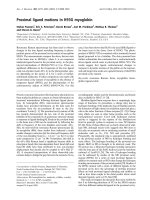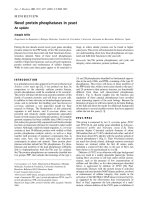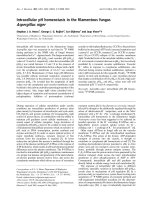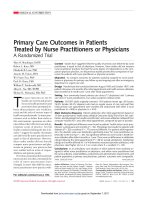Báo cáo y học: "β2 adrenergic agonists in acute lung injury" ppsx
Bạn đang xem bản rút gọn của tài liệu. Xem và tải ngay bản đầy đủ của tài liệu tại đây (50.56 KB, 2 trang )
Available online />Page 1 of 2
(page number not for citation purposes)
Abstract
Despite extensive research into its pathophysiology, acute lung
injury/acute respiratory distress syndrome (ALI/ARDS) remains a
devastating syndrome with mortality approaching 40%. Pharma-
cologic therapies that reduce the severity of lung injury in vivo and
in vitro have not yet been translated to effective clinical treatment
options, and innovative therapies are needed. Recently, the use of
β
2
adrenergic agonists as potential therapy has gained
considerable interest due to their ability to increase the resolution
of pulmonary edema. However, the results of clinical trials of β
agonist therapy for ALI/ARDS have been conflicting in terms of
benefit. In the previous issue of Critical Care, Briot and colleagues
present evidence that may help clarify the inconsistent results. The
authors demonstrate that, in oleic acid lung injury in dogs, the
inotropic effect of β agonists may recruit damaged pulmonary
capillaries, leading to increased lung endothelial permeability.
In their manuscript, Briot and colleagues [1] assessed the
role of terbutaline, a β
2
agonist, on lung microvascular
permeability in an acute lung injury (ALI) in vivo model to
uncover the underlying mechanisms of therapeutic benefit.
The authors used a recently developed broncho-alveolar
lavage technique [2] to repeatedly measure (every 15 minutes)
the time-course of capillary-alveolar leakage of a macro-
molecule, fluorescein-labeled dextran (FITC-D70), in 19 oleic
acid (OA) lung injured dogs. With OA injury, the transport
rate of coefficient of FITC-D70, used as a measure of permea-
bility, from blood to alveoli increased sharply and peaked at
30 minutes. Thereafter, FITC-D70 leakage decreased gradually
until the end of the experiment at 4 hours. Surprisingly, the
infusion of terbutaline, given following 90 minutes of OA injury,
interrupted the recovery phase, further aggravating FITC-D70
leakage. The authors discovered that with the onset of
terbutaline infusion at 0.25 μg/kg/minute, the β
2
inotropic
effect of the drug significantly [3] increased the cardiac
output and pulmonary artery pressure by 50% and 30%,
respectively, while decreasing the pulmonary vascular
resistance by 40%. With increased pulmonary vascular
recruitment, the authors surmised that the terbutaline infusion
increased perfusion surface area or recruited leaking
capillaries from hypoxic vasoconstriction, which led to an
aggravation of FITC-D70 leakage into the alveoli.
Previously, β
2
agonist therapy was considered promising for
ALI based on several characteristics seen in both animal and
human models: the ability to increase the rate of vectorial salt
and water transport by increased intracellular cAMP, leading
to improved alveolar fluid clearance (AFC) [4,5] - clinically,
impaired AFC in patients with ALI is associated with higher
mortality [6]; the ability to improve lung endothelial permea-
bility to protein [7]; and the anti-inflammatory properties of β
2
agonists. Maris and colleagues [8] demonstrated that pre-
treatment with an inhaled β
2
agonist markedly reduced
neutrophil influx, neutrophil degranulation and accumulation
of tumor necrosis factor α in the airspaces of human
volunteers exposed to inhaled endotoxin.
However, the results of clinical trials of β agonist therapy for
ALI/acute respiratory distress syndrome (ARDS) have been
inconsistent. In a randomized placebo controlled clinical trial
of 40 patients with ALI (Beta-Agonist Lung Injury Trial
(BALTI)), Perkins and colleagues [9] found that salbutamol
(albuterol) given intravenously at a dose of 15 μg/kg/h
reduced extravascular lung water in patients with ALI/ARDS
as measured by thermodilution (PiCCO) at day 7 compared
to placebo control subjects. Whereas Matthay and
colleagues [10] in another randomized, placebo-controlled
Commentary
ββ
2
adrenergic agonists in acute lung injury? The heart of the
matter
Jae W Lee
Departments of Anesthesiology and the Cardiovascular Research Institute,
University of California, San Francisco, 505 Parnassus Ave, San Francisco, CA 94143, USA
Corresponding author: Jae-Woo Lee,
Published: 7 December 2009 Critical Care 2009, 13:1011 (doi:10.1186/cc8171)
This article is online at />© 2009 BioMed Central Ltd
See related research by Briot et al., />AFC = alveolar fluid clearance; ALI = acute lung injury; ARDS = acute respiratory distress syndrome; OA = oleic acid.
Critical Care Vol 13 No 6 Lee
Page 2 of 2
(page number not for citation purposes)
trial (Albuterol for the Treatment of ALI (ALTA)) by the ARDS
Network of an aerosolized β
2
adrenergic agonist (albuterol)
for ALI found no significant difference in their primary study
endpoint of ventilator free days (to 28 days) or 60-day
mortality between treatment groups. The study was stopped
by the Data Monitoring Board at the first interim analysis for
futility following 279 patients who received the study drug.
The study by Briot and colleagues [1] suggests that the
inotropic effect of β agonist therapy may influence outcome
by increasing perfusion surface area, further aggravating
pulmonary edema.
The strength of their paper is the development of an in vivo
technique to measure lung endothelial permeability in ALI
models across the capillary endothelial, interstitial and
alveolar epithelial monolayers without the influence of AFC on
the measurement. In ALI, changes in AFC rate do not
necessarily correlate with changes in lung endothelial
permeability [11]; however, either parameter can influence
the measurement of the other. The broncho-alveolar lavage
sampling process avoids this potential error by ensuring
supra-maximal AFC rate (48%/h) in their calculations,
allowing the authors to measure the effect of OA on
permeability and the perfusion surface area of the lung
capillaries in isolation. However, the major limitations are the
severity and short time period of OA injury reflecting an early
phase of ALI and the inability to use the in vivo technique
beyond 4 hours due to a spontaneous aggravation of lung
permeability in the control lung. The beneficial effect of β
agonists on the capillary-alveolar membrane may take longer
to become apparent than their effects on inflammation [8]
and wound healing [12].
In the future, the significance of the inotropic effect of β
agonists for ALI patients will need to be clarified. However,
studies like that of Briot and colleagues highlight a major
limitation of using pharmacological monotherapy such as β
agonists or activated protein C [13] in ARDS: the complex
and inter-related interactions in the pathophysiology of
ARDS, such as the relationship between impaired AFC and
lung endothelial permeability, and the inability of one therapy
to address all simultaneously.
Competing interests
The author declares that he has no competing interests.
References
1. Briot R, Bayat S, Anglade D, Martiel JL, Grimbert F: Increased
cardiac index due to terbutaline treatment aggravates capil-
lary-alveolar macromolecular leakage in oleic acid lung injury
in dogs. Crit Care 2009, 13:R166.
2. Briot R, Bayat S, Anglade D, Martiel JL, Grimbert F: Monitoring
the capillary-alveolar leakage in an A.R.D.S. model using
broncho-alveolar lavage. Microcirculation 2008, 15:237-249.
3. Schäfers RF, Adler S, Daul A, Zeitler G, Vogelsang M, Zerkowski
HR, Brodde OE: Positive inotropic effects of the beta 2-
adrenoceptor agonist terbutaline in the human heart: effects
of long-term beta 1-adrenoceptor antagonist treatment. J Am
Coll Cardiol 1994, 23:1224-1233.
4. Matthay MA, Folkesson HG, Clerici C: Lung epithelial fluid
transport and the resolution of pulmonary edema. Physiol Rev
2002, 82:569-600.
5. Sartori C, Allemann Y, Duplain H, Lepori M, Egli M, Lipp E, Hutter
D, Turini P, Hugli O, Cook S, Nicod P, Scherrer U: Salmeterol for
the prevention of high-altitude pulmonary edema. N Engl J
Med 2002, 346:1631-1636.
6. Ware LB, Matthay MA: Alveolar fluid clearance is impaired in
the majority of patients with acute lung injury and the acute
respiratory distress syndrome. Am J Respir Crit Care Med
2001, 163:1376-1383.
7. McAuley DF, Frank JA, Fang X, Matthay MA: Clinically relevant
concentrations of beta2-adrenergic agonists stimulate
maximal cyclic adenosine monophosphate-dependent air-
space fluid clearance and decrease pulmonary edema in
experimental acid-induced lung injury. Crit Care Med 2004,
32:1470-1476.
8. Maris NA, de Vos AF, Dessing MC, Spek CA, Lutter R, Jansen
HM, van der Zee JS, Bresser P, van der Poll T: Antiinflammatory
effects of salmeterol after inhalation of lipopolysaccharide by
healthy volunteers. Am J Respir Crit Care Med 2005, 172:878-
884.
9. Perkins GD, McAuley DF, Thickett DR, Gao F: The beta-agonist
lung injury trial (BALTI): a randomized placebo-controlled clin-
ical trial. Am J Respir Crit Care Med 2006, 173:281-287.
10. Matthay M, Brower R, Thompson BT, Schoenfeld D, Eisner MD,
Carson S, Moss M, Douglas I, Hite D, MacIntyre N, Liu KD: Ran-
domized, placebo-controlled trial of an aerosolized beta-2
adrenergic agonist (albuterol) for the treatment of acute lung
injury. Am J Respir Crit Care Med 2009, 179:A2166.
11. Wiener-Kronish JP, Albertine KH, Matthay MA: Differential
responses of the endothelial and epithelial barriers of the
lung in sheep to Escherichia coli endotoxin. J Clin Invest 1991,
88:864-875.
12. Perkins GD, Gao F, Thickett DR: In vivo and in vitro effects of
salbutamol on alveolar epithelial repair in acute lung injury.
Thorax 2008, 63:215-220.
13. Liu KD, Levitt J, Zhuo H, Kallet RH, Brady S, Steingrub J, Tidswell
M, Siegel MD, Soto G, Peterson MW, Chesnutt MS, Phillips C,
Weinacker A, Thompson BT, Eisner MD, Matthay MA: Random-
ized clinical trial of activated protein C for the treatment of
acute lung injury. Am J Respir Crit Care Med 2008, 178:618-
623.









